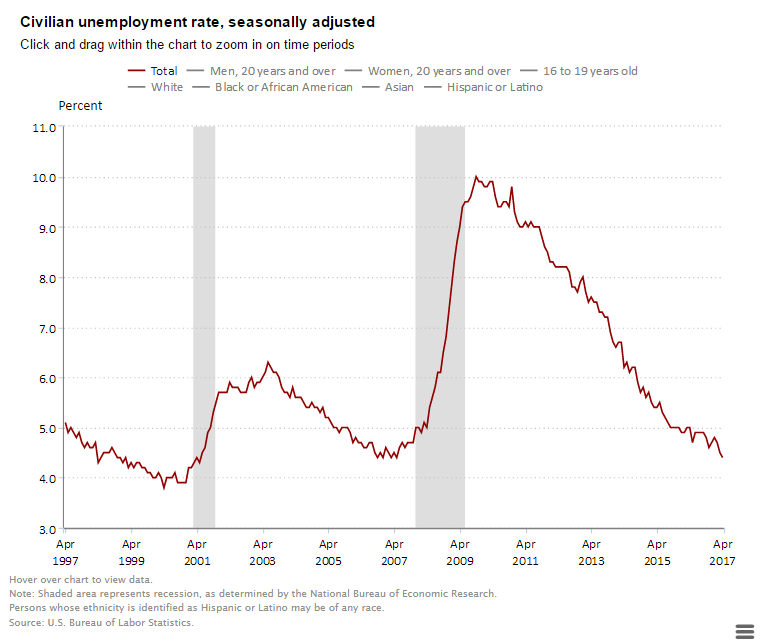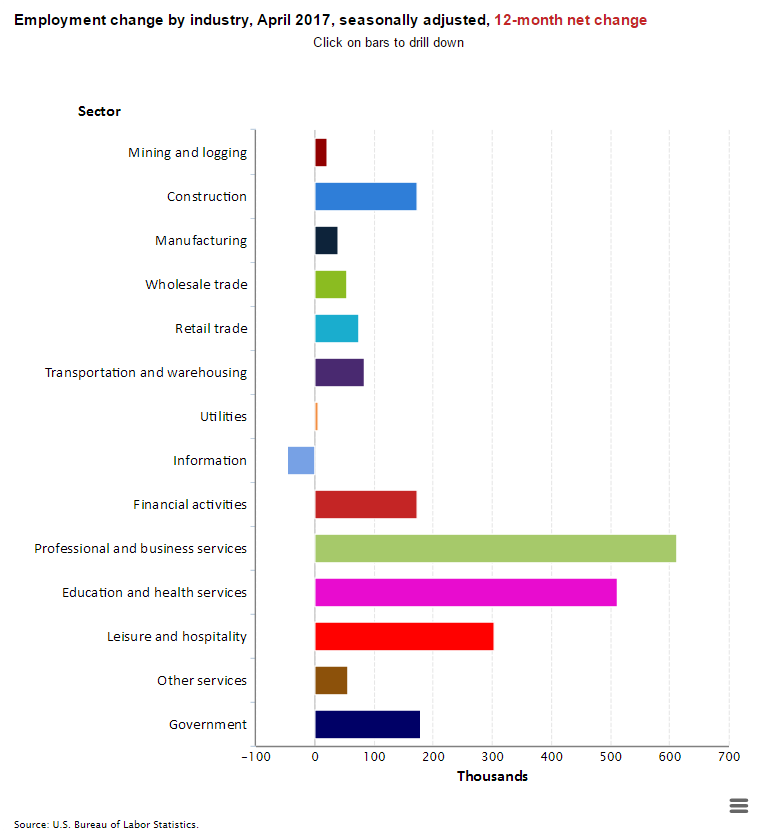The Labor Department reported on Friday that nonfarm payrolls increased by a seasonally-adjusted 210,000 positions in April, well above the consensus 190,000 estimate. This followed gains of 79,000 in March, originally reported as 98,000 and 232,000 in February, originally reported as 219,000. The weak March payroll increase appears to have been weather related. Monthly revisions result from additional reports received from businesses since the last published estimates and from the recalculation of seasonal factors. Over the past 4 months, job gains have averaged 185,000 per month, almost identical to the 187,000 monthly pace in 2016.
Employment in health care rose by 20,000 in April, on par with the average monthly gain since the beginning of 2017, but below the average monthly gain of 32,000 in 2016.

The unemployment rate fell 10 basis points to 4.4% in April and was down 0.6 percentage point from year-earlier levels. The unemployment rate is derived from a separate survey than the payroll employment number sited above. The Labor Department has two surveys, one of businesses and one of households. The unemployment data is based on the household survey, while the hiring employment data is based on the business survey.
Further downward pressure on the unemployment rate is likely to occur in the coming months as job growth exceeds labor force growth. This will put it further below the so called full-employment or natural equilibrium level; indeed, the official estimate by the Federal Reserve of the full-employment level of unemployment is 4.7%. A rate much below this rate is believed to fuel inflation through upward pressure on wage rates.
A broader measure of unemployment, which includes those who are working part-time but would prefer full-time jobs and those that they have given up searching—the U-6 unemployment rate—fell 30 basis points to 8.6% in April.
The labor force participation rate, which is a measure of the share of working-age people who are employed or looking for work fell slightly to 62.9% from 63.0% in March. It is very low by historic standards and in part reflects the effects of retiring baby boomers.
The number of unemployed persons fell by 854,000 from year-earlier levels to 7.1 million. The number of long-term unemployed, i.e., those unemployed for more than 6 months, totaled 1.6 million and accounted for roughly 22.6% of those unemployed.
Average hourly earnings for all employees on private nonfarm payrolls increased by seven cents to $26.19 in April. Over the year, average hourly earnings have risen by 65 cents or 2.5%. This is down slightly from a downwardly revised 2.6% rate in March (originally reported as 2.7%) and on par with the 2.6% average in 2016. In 2015 this figure was 2.3% and in 2014, it was 2.1%. Increases in minimum wage rates in many states and tightening labor markets may start to put further pressure on this measure of earnings.

The relatively strong monthly job gain, the drop in the jobless rate to 4.4% and the 2.5% year-over-year increase in wages will provide a compelling reason for the Federal Reserve to consider further rate hikes at its next meeting on June 13th and 14th. The data suggest that the economy is strong enough to absorb further interest rate increases. The combination of low stable inflation and full employment—will give the Fed confidence that further rate hikes are in order. At this point, they have stated that two more rate hikes are planned for 2017. The Fed has also implied that it plans to start gradually reducing a large portfolio of mortgage and Treasury bonds on its balance sheet, a further way to make monetary policy less accommodative.
About Beth Mace
Beth Burnham Mace is a special advisor to the National Investment Center for Seniors Housing & Care (NIC) focused exclusively on monitoring and reporting changes in capital markets impacting senior housing and care investments and operations. Mace served as Chief Economist and Director of Research and Analytics during her nine-year tenure on NIC’s leadership team. Before joining the NIC staff in 2014, Mace served on the NIC Board of Directors and chaired its Research Committee. She was also a director at AEW Capital Management and worked in the AEW Research Group for 17 years. Prior to joining AEW, Mace spent 10 years at Standard & Poor’s DRI/McGraw-Hill as director of its Regional Information Service. She also worked as a regional economist at Crocker Bank, and for the National Commission on Air Quality, the Brookings Institution, and Boston Edison. Mace is currently a member of the Institutional Real Estate Americas Editorial Advisory Board. In 2020, Mace was inducted into the McKnight’s Women of Distinction Hall of Honor. In 2014, she was appointed a fellow at the Homer Hoyt Institute and was awarded the title of a “Woman of Influence” in commercial real estate by Real Estate Forum Magazine and Globe Street. Mace earned an undergraduate degree from Mount Holyoke College and a master’s degree from the University of California. She also earned a Certified Business Economist™ designation from the National Association of Business Economists.
Connect with Beth Mace
Read More by Beth Mace